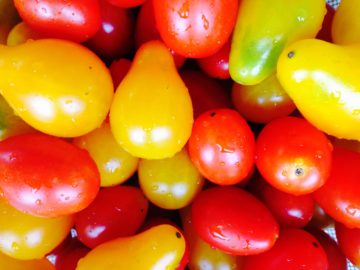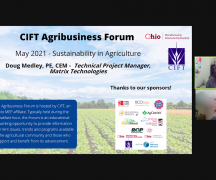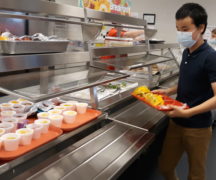By DAVID DUPONT
BG Independent News
A week before the day when Americans celebrate eating, Karen Bakies, of the National Dairy Council, gave a presentation highlighting facts and trends in how we consume food.
And, she noted, we will consume a lot this Thanksgiving. She projected a graphic with such holiday favorites from dark turkey, green bean casserole, sausage stuffing, cranberry sauce, and, of course, pumpkin pie with whipped cream.
Tally that up, she said, and you get 2,500 calories. That’s about a recommended daily intake for a day for most adults. Add in a couple glasses of wine and the inevitable seconds, and that can balloon to 4,500 calories. One meal, one day. But consuming extra calories is just a holiday tradition.
 Americans are battling obesity and the diabetes it too often brings on, she said. Still very few of us, she said, are eating enough fruits and vegetables, whole grains or dairy.
Americans are battling obesity and the diabetes it too often brings on, she said. Still very few of us, she said, are eating enough fruits and vegetables, whole grains or dairy.
That was the first of 10 talking and points and trends Bakies expects that as a nutrition educator she’ll be looking forward to in 2018.
Bakies was the featured speaker at the November Northwest Ohio Ag-Business Breakfast Forum hosted by the Center for Innovative Food Technology at the Agricultural Incubator Foundation.
There’s nothing simple about eating. “Nutrition is more complicated than astrophysics,” Bakies said.
People eat, of course, to gain the energy they need to live, but other emotional dynamics are at work. Food is seen as an experience to be photographed and shared over social media. Food is a way of curing or fending off disease.
Food is about values. That’s especially true for millennials and the younger Gen Z, whose members are just now starting their college careers. They wear their food choices like a badge, Bakies said.
What people consume defines who they are and what they stand for.
Here’s what will shape our talk about eating.
- Fattening up
Topping her list of talking points for 2018 is obesity and diabetes, both of which continue to rise. About a third of adults and child are classified as obese and 11.1 percent have Type 2 diabetes.
Given a child’s eating habits are established early, before they are 5, intervention needs to start at a very young age, Bakies said.
Children who carry excess weigh when they start kindergarten are four times more likely to be obese by eighth grade than normal-weight children.
- Snack time
We are becoming a nation of snackers – 91 percent eat multiple snacks throughout the day, and 8 percent report never eating a regular meal, just snacking.
“This is an area where we’ll have to do a lot more education,” Bakies said.
- Fat findings
The view of fat in food is changing. There’s a split between the World Health Organization and the American Heart Association on whether the consumption of saturated fat causes cardiovascular disease. The WHO says no, the Heart Association says yes.
 “It’s hard to look at a single element and see how it affects the body,” Bakies said. There are 400 types of fatty acids, for example. How they work solo may be very different than when “acting in a package.”
“It’s hard to look at a single element and see how it affects the body,” Bakies said. There are 400 types of fatty acids, for example. How they work solo may be very different than when “acting in a package.”
Also, studies have determined that eating dietary cholesterol has any relation to developing serum cholesterol.
She recalled the advice to greatly limit consumption of eggs because of concern about cholesterol. That’s now been changed, especially given eggs are an excellent and inexpensive source of protein and other essential nutrients.
“That’s really where the research is heading instead of looking at nutrients in isolation,” Bakies said.
But there’s consensus that trans fats are associated with all sorts of diseases, she said.
- Sweetening up
Added sugars are becoming more prevalent especially in snack foods and beverages, she said. The new dietary guidelines recommend that less than 10 percent of calories consumed a day come from added sugars, as opposed to naturally occurring sugars.
The new nutritional labeling coming in 2020 will distinguish between the two.
- Got milk or almond beverage?
As a representative of the Dairy Council, Bakies is particularly concerned about the proliferation of alternatives to milk.
The Dairy Council asked the FDA to keep producers of beverages made from soy, coconut, and almond from calling these milk. The FDA ruled against the council, allowing the use of milk as long as it was clearly labeled as almond, soy or coconut milk.
These beverages are not “nutritionally equivalent” to milk, Bakies said. The labeling of ingredients and nutrients varies from product to product, so consumers need to be careful.
Bakies noted that only one brand of soy milk has been approved for distribution through the WIC supplemental food program.
- Cooking skills not making the cut
Cooking skills are on the decline. That includes knife skills, which are considered essential. Home economics is no longer required in schools. Now people turn to YouTube for advice. In addition to eating out and getting take out, a growing segment of the restaurant business, people are using other solutions such as Hello Fresh and Blue Apron, where all the ingredients to prepare a meal are shipped to them.
The amount of time people spend preparing food varies according to age, with the youngest cooking less and the oldest more as well as by economic status. People receiving SNAP and WIC benefit spend far more time cooking than the average American.
- Let’s be clear
Transparency is an increasing concern. People want to be told what’s in their food, with attention to additives and how it’s processed.
They also want to know where it was produced, if animals are treated humanely, and whether employees are treated fairly.
- Information overload
But consumers are also bombarded with information from sources both credible and often not credible. Consumers can receive 4,500 social media messages daily.
It’s hard to shift through this overflow of food info and findings. Googling for the answer to a nutrition question doesn’t necessarily produce the right answer in the top search results.
“How do we get to the science?” Bakies asked. “Nothing is black and white. There’s a lot of gray. And things change over time. That’s why people get confused.”
When looking at reports of studies about nutrition, consumers should look for three elements.
Was the study done with humans? The more the better, she said.
Over what period of time was it conducted? The longer the better.
How many studies have been done? The more the better.
- New labels on the way
New nutrition labels will be implemented in 2020, the first update in 20 years.
Often, though, consumers are judging what’s healthy based on what’s not in the food, and often they are confused about those issues.
Some foods, for example, are labeled as not being genetically modified, even though those foods are not approved as GMOs. There’s also confusion over the extent of use of growth hormones and antibiotics in food. “Everything is antibiotic free,” Bakies said.
What’s natural, or local, or organic are all matters for debate.
- Nourishing earth & body
The last trend, Bakies noted, is the promotion of sustainable nutrition. That’s a system that’s good for the earth and the body.
A related issue is the fight against food waste. “I think of it as nutrient loss,” she said.
Most food waste happens at home. Often it has to do with a confusion over what the dates stamped on food mean. “Food safety and food waste are so interconnected.”
Bakies tagged on an addendum to her talk. Far too many people are isolated from food production. Only 2 percent of the population is involved in agriculture.
Colleges are no longer requiring those studying to be dieticians to study how food is produced. Fewer students are coming from farm backgrounds. When she asks students at Ohio State, how many came from farming families only a hand or two goes up. It was noted that at BGSU the number tends to be much higher.
Farmers need to throw open the barn doors, and let people see how food is produced to overcome this gap.
She concluded with a quote from writer Wendell Berry: “Eating is an agricultural act.”





